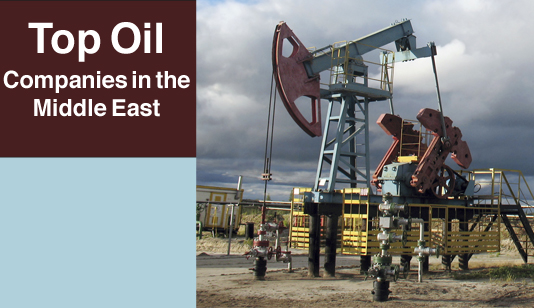Doing Business in the Middle East:
Top Oil Companies in the Middle East
For over four decades, Middle Eastern oil producing companies have kept an iron grip on the worldwide oil market. With nearly two-thirds of the world’s oil being produced in the Middle East many large consumers of oil have been scrambling to locate and produce oil production at home. We are going to provide you with a list of the Top Oil Companies in the Middle East and some interesting oil related information along the way. Consistent up to date data about revenues and exact oil production are hard to come by for some of the Middle Eastern companies producing oil, but we have put together the most accurate list based upon with the information available starting with the ninth largest and working up to the largest.
#9 Oman Oil Company (OOC)
The Oman Oil Company produces almost one million barrels of crude oil per day. The company, owned by the Government of Oman, was established in 1996 and is headquartered in Muscat, Oman. Chief Executive Officer (CEO) is Ahmed Al-Wahaibi. (Editors Note: Mr Al-Wahaibi was recently jailed for 23 years for accepting bribes, abuse of office and money laundering).
#8 National Oil Corporation, Libya (NOC)
The National Oil Corporation is based in Libya and is owned by the Government of Libya. Founded in 1970, the NOC Chairman is Nuri Berruien and the company is located in Tripoli, Libya. It is believed that this company produces c2.2 million barrels of oil per day. Turmoil in Libya over the past several years has led to inconsistency in oil production and thus, supporting data.
#7 Sonatrach
Sonatrach is the biggest oil producing company in Northern Africa, producing 2.2 million barrels of crude per day. The company is owned by the Algerian Government and reported US$ 76.1 billion of revenue in 2012. The CEO is Abdelhamid Zerguine and Sonatrach has oil partnerships with both Libya and Tunisia.
#6 Iraq National Oil Company (INOC)
The Iraq National Oil Company is owned by the Government of Iraq. Oil production is at 2.2 million barrels per day. Founded in 1966 the INOC reported revenues of US$ 51.4 billion in 2010. Once again changes in Iraq over the last decade have affected production. However, Iraq did produce 2.8 million barrels per day in January 2014, and are projecting to produce 3.4 million per day very soon.
#5 Abu Dhabi National Oil Company (ADNOC)
The Abu Dhabi National Oil Company is owned by the Government of the United Arab Emirates (UAE). The company was founded in 1971 in Abu Dhabi, UAE. The Chairman of the Supreme Petroleum Council is Sheikh Khalifa bin Zayed Al Nahyan. ADNOC produces 2.4 million barrels of oil per day. Revenue was reported at 75 billion in 2011.
#4 Kuwait Oil Company (KOC)
The Kuwait Oil Company was founded in 1934. It possibly produces in the region of 3.4 million barrels of oil per day, making it the fourth largest exporter of oil on the planet. The company is headquartered in Ahmadi, Kuwait and is a subsidiary of the Kuwait Petroleum Corporation, owned by the Government of Kuwait.
#3 Qatar Petroleum
Qatar Petroleum holds the distinction of being the third largest producer and exporter of oil in the Middle East. Founded in 1974 and owned by the Government of Qatar, Qatar Petroleum now produces 5.3 million barrels of oil per day. Company headquarters sits in Doha, Qatar and Minister of Energy and Production is Mohammed Bin Saleh Al-Sada. The company posted US$ 51.6 billion worth of revenue in 2011.
#2 National Iranian Oil Company (NIOC)
The National Iranian Oil Company was founded in 1948. It is owned by the Government of Iran and located in Tehran, Iran. The company has some 23 subsidiaries. Revenue was believed to be US$ 110 billion in 2012. The CEO of the company is Roknoldin Javadi. NIOC produces somewhere in the region of 6 million barrels of oil per day, even though this may vary due to sanctions placed upon the country.
#1 Saudi Aramco
Saudi Aramco is not only the biggest oil producing company in the Middle East, it is the largest in the world. It is also known as the Saudi Arabian Oil Company. The company is valued at over ten trillion dollars. Founded in 1933, although it did not take on the present name until 1988, its headquarters are based in Dhahran, Saudi Arabia. Saudi Aramco reported revenue of US$ 311 billion in 2012 and is owned by the Saudi Arabian Government. Khalid A. Al-Falih is the CEO. They produce some 12.7 million barrels of oil per day. In January 2014, Saudi Arabia exported over 240 million barrels of oil.
Information about Oil Production and the Environment
Oil Companies have been drilling for oil for nearly a century and a half. Technology has improved since then and crude oil has made all of our lives easier. The majority of oil is used to create fuel for transport. It is also used in the production of plastics, which have also seen substantial growth over the last century. The growing need for more and more oil has put the world between a rock and a hard place. Much of the oil is found near the top of the earth’s crust. However, in some areas of the world that readily available oil has already been exhausted.
This has caused oil companies to take additional measures to dig deeper and force the oil reserves to the surface. Today, many are investing in the latest method of producing oil from shale formations. It is a good thing that we are finding more ways to find the oil we depend upon so much in our daily lives, but the exploration and production comes at a cost to our environment. Our air is constantly polluted and overwhelmed with greenhouse gas emissions, which has been instrumental in climate change. You will find plenty who doubt any direct link between the two; strangely enough, many of these doubters are associated (in some way) with oil production.
An increasing number of trees are cut down to make room for drilling and pipelines. The transport of oil has also left its mark on our environment. It was not that long ago that the Exxon Valdez oil spill devastated the environment. Drilling at offshore locations has also come at a high cost to the environment, as was witnessed by major oil spills a decade ago at Terra Nova in Nova Scotia, and just four years ago in the Gulf of Mexico from the BP platform. Oil production has not been a friend of our environment.
Oil Consumption
It is estimated that the United States imports 60 million barrels of oil per month from the gulf region. However, the U.S. has directed their attention to shale oil, which they hope will reduce their dependence on foreign oil by 2020. India imports 44% of their oil and this amount is expected to increase. China imports half of their oil from the area, and other Asian based countries such as South Korea and Japan also depend on oil supplies delivered through the Strait of Hormuz.
How Politics have affected Middle East oil production
Unfortunately, oil production in the Middle East has been affected by politics more than production restraints. Foreign superpowers have long cast a shadow over the Gulf Region. Many countries, including Iraq and Libya, have witnessed conflict suggested to be over ‘political reasons’, but often suspected to be over oil.
One must make ones own conclusions as to what circumstances justify the participation of those countries from outside the Middle East. The one factor that stands clear is that crude oil in this region of the world is so important that anyone depending on it will do anything to protect it.
Thankfully, Iraq seems to be back on track with its oil production – however, Libya’s oil production is still clouded with uncertainty. Much political interaction gives cause for questions and cynicism.
The Future of the Global Oil Consumption
It is projected that over the next decade many countries in the western hemisphere will reduce their importation of Middle Eastern oil. This will be greatly due to those countries investing more money and technology into producing oil at home. There are some projections that suggest the United States could be producing 80% of its own oil as early as 2020 and completely eliminate imports from the Middle East by 2035. Time will tell, but even if this is the case; Middle Eastern oil will still be in great demand.
We can say this because for one thing, many countries in Asia will see an expansion in oil consumption over the same period. In addition, the Middle East itself will see a dramatic increase in oil consumption. For now, Europe gets a significant amount of oil from Russia, but that could always change. Turkey signed off on an agreement in the summer of 2012 with the Kurdistan Regional Government to trade refined petroleum for crude oil.
Although the United States definitely receives a good share of Middle Eastern oil; there will be plenty of consumers around the globe that will need to fulfill their consumption.
New Oil Technology and Production in the West
The United States, Canada, and their Latin neighbours in South America, are working together to pursue new organic oil production in the western hemisphere using the latest oil-producing technology. Many oil reserves have been located below the ocean floor, in the sand, and most impressively, in organic shale rock formations. Through the use of a relatively new – but extremely controversial – process referred to as “fracking”, the United States and other regional countries are able to produce oil from shale. This could potentially open up an enormous oil reserve for the west. This is one of the reasons that experts suggest the USA could eliminate the need for Middle Eastern oil by 2035.
Some countries are looking further into this process and producing organic oil from kerogen shale and other natural resources. Oil shale, also known as kerogen shale, is an organic-rich fine-grained sedimentary rock containing kerogen, a solid mixture organic chemical compounds from which liquid hydrocarbons called shale oil (not to be confused with crude oil, occurring naturally in shale) can be produced.
Information on Middle Eastern Oil Price Influence
The influence Middle Eastern oil companies have on the price of a barrel of oil cannot be ignored. The price of a barrel of oil is vastly related to the amount of oil the Middle Eastern companies are willing to produce from their vast reserves. When production is reduced, the price of oil goes up because less is available on the market. The price of oil can be influenced by many things, including politics, but right now the Middle East oil producing companies play a major role in influencing the market price of oil. OPEC, or the Organization of Petroleum Exporting Countries, carries significant influence.
Crude oil price per barrel, as of 15 April, 2014 trades at US$ 103.85




























